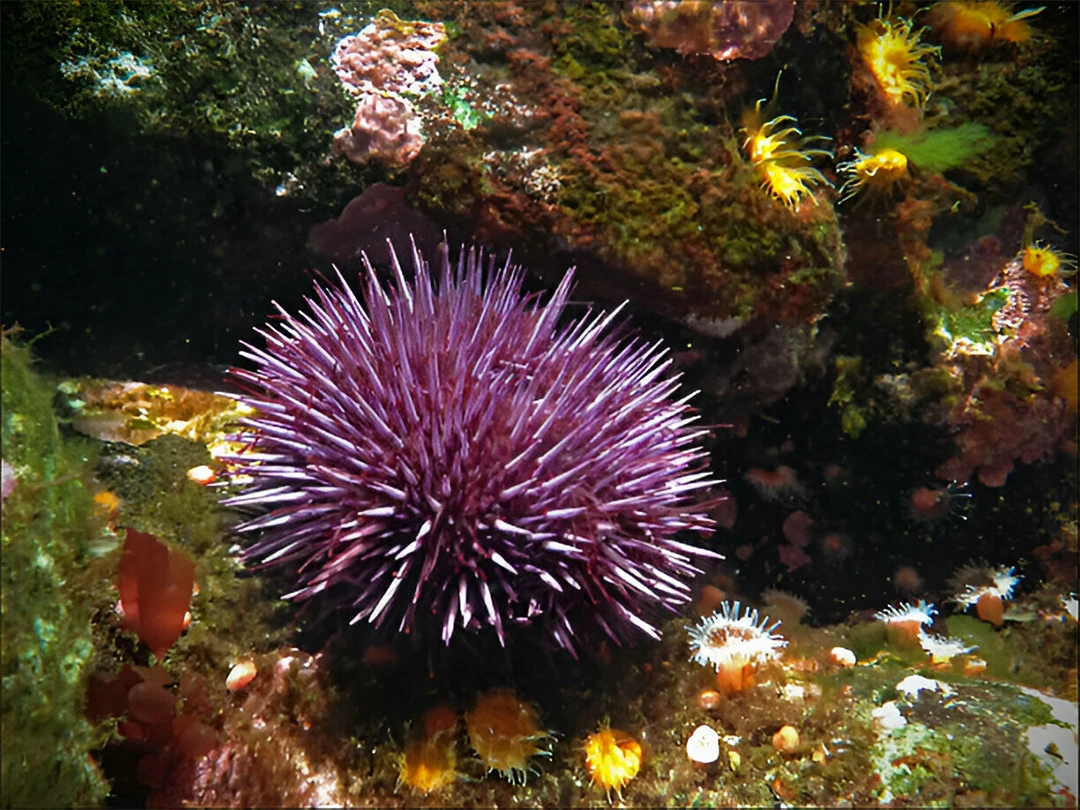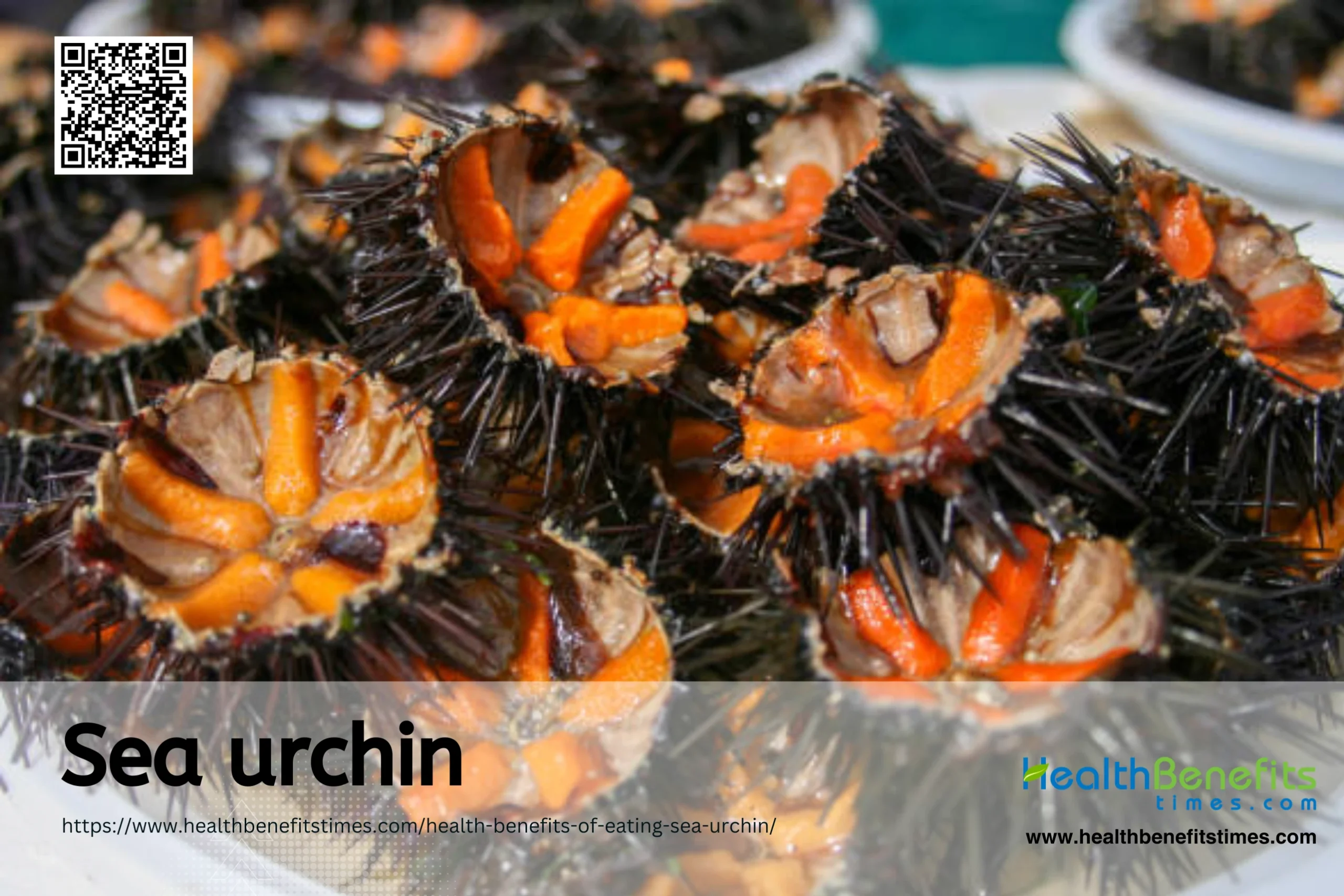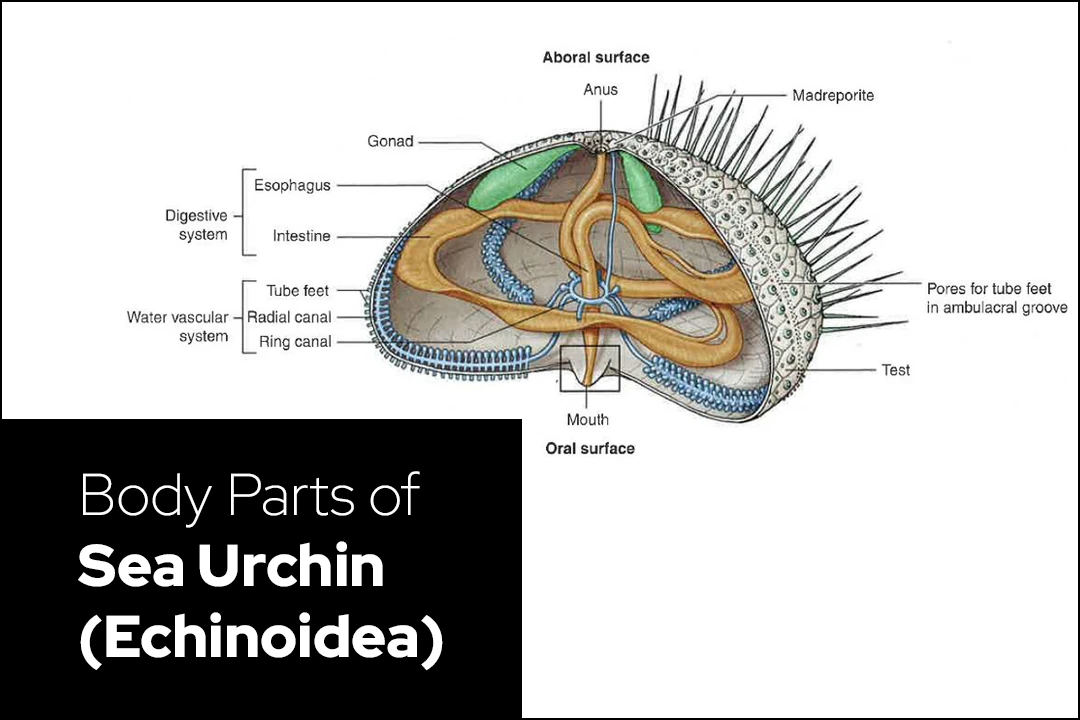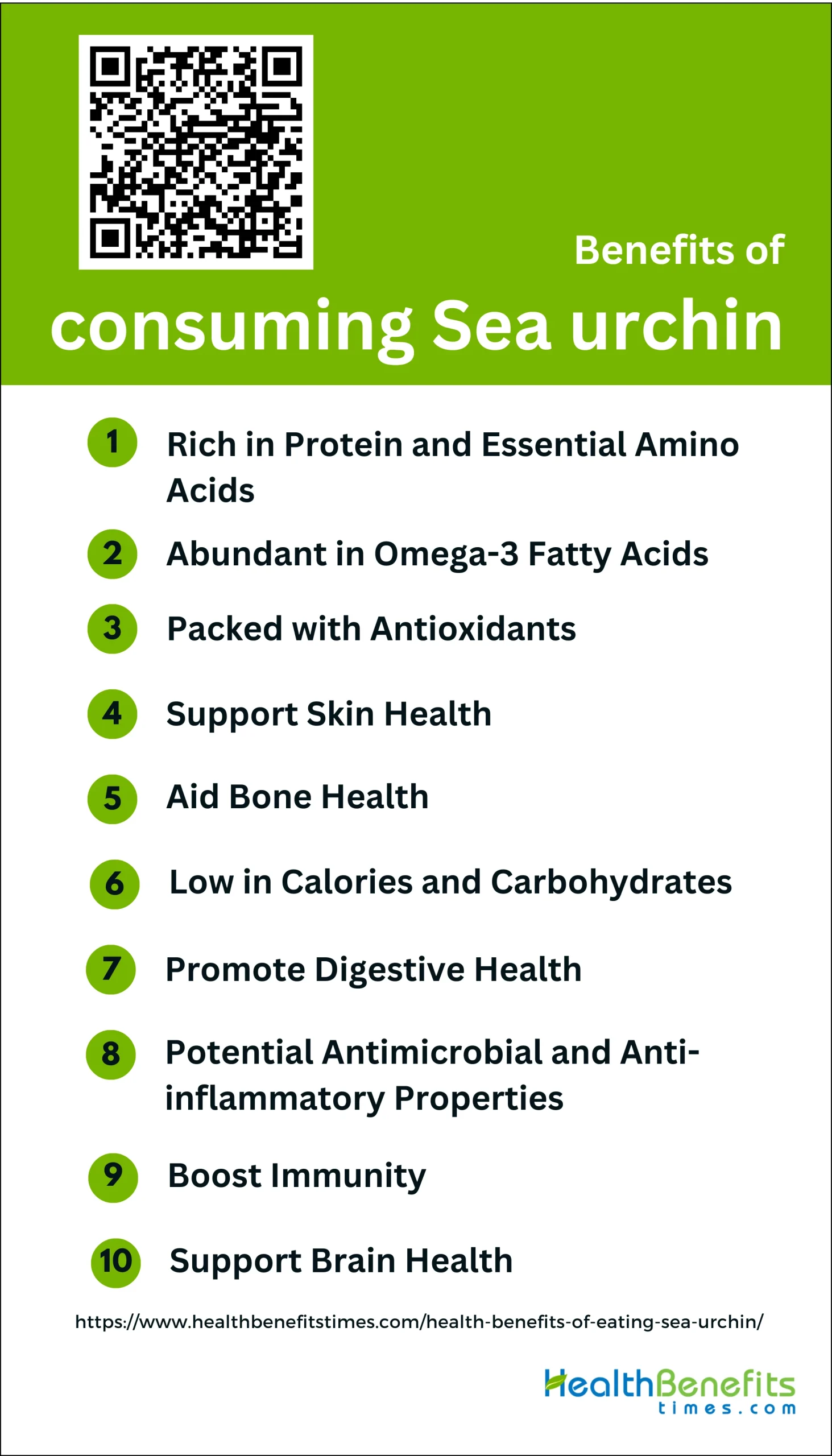What is Sea urchin (Echinoidea)?
Sea urchins, also known as Echinoidea, are prickly marine creatures that belong to the Echinodermata group. With about 950 different types found in oceans worldwide, from shallow waters to the deep sea, these creatures have round, spiky shells usually measuring between 3 to 10 cm across. They move slowly using tube feet and mainly munch on algae, although some are into a bit of everything.
As adults, sea urchins display symmetrical five-part patterns, while their larvae have two-sided symmetry, showing their link to animals like chordates and arthropods. These ancient beings have been around since the Ordovician period, dating back some 450 million years, making them one of the oldest deuterostome groups out there.
Body Parts of Sea Urchin (Echinoidea)
1. Mouth
The mouth of a sea urchin is located on the oral side, which is the underside of the animal. It is surrounded by a structure known as the peristome and contains five calcareous teeth arranged in a complex feeding apparatus called Aristotle’s lantern. This structure allows the sea urchin to scrape algae and other food particles from surfaces. The mouth is a crucial part of the sea urchin’s digestive system, facilitating the intake of food which is then processed through the esophagus and intestines.
2. Test
The test is the hard, calcareous shell of the sea urchin, composed of fused plates that form a rigid structure. It provides protection and structural support to the sea urchin’s body. The test is covered with spines and pedicellariae, which are small pincer-like structures used for defense and cleaning. The test also contains pores through which the tube feet extend, allowing for movement and interaction with the environment.
3. Pores for Tube Feet in Ambulacral Groove
The ambulacral grooves are channels on the surface of the sea urchin’s test that contain rows of pores. These pores are openings through which the tube feet extend. The tube feet are part of the water vascular system and are used for locomotion, feeding, and respiration. The arrangement and number of these pores can vary among different species of sea urchins, but they are essential for the animal’s ability to move and interact with its surroundings.
4. Madreporite
The madreporite is a sievelike structure located on the aboral (upper) surface of the sea urchin. It serves as the entry point for seawater into the water vascular system, which is crucial for the operation of the tube feet. The madreporite filters the water before it enters the system, ensuring that debris and particles do not clog the delicate internal structures. This component is vital for maintaining the hydraulic pressure needed for the tube feet to function properly.
5. Esophagus
The esophagus is a tube that connects the mouth to the stomach in sea urchins. It is part of the digestive system and is responsible for transporting ingested food from the mouth to the stomach for further digestion. The esophagus is relatively short and straight, facilitating the efficient movement of food particles. It plays a crucial role in the initial stages of digestion, ensuring that food reaches the stomach where it can be broken down and absorbed.
6. Intestine
The intestine of a sea urchin is a long, coiled tube that extends from the stomach to the anus. It is responsible for the absorption of nutrients from the digested food. The intestine is lined with specialized cells that facilitate the breakdown and absorption of nutrients, ensuring that the sea urchin can extract the maximum amount of energy from its food. The structure and length of the intestine can vary among species, but it is always a critical component of the digestive system.
7. Gonad
The gonads of sea urchins are the reproductive organs, and they are located within the test. Sea urchins have five gonads, which can be either male or female, producing sperm or eggs, respectively. The gonads are highly valued in some cultures as a delicacy known as “roe.” They play a crucial role in the reproductive cycle of sea urchins, releasing gametes into the water column for external fertilization. The size and condition of the gonads can vary seasonally, often increasing in size during the breeding season.
8. Tube Feet
Tube feet are small, flexible, and extendable appendages that protrude through the pores in the ambulacral grooves of the sea urchin’s test. They are part of the water vascular system and are used for locomotion, feeding, and respiration. Tube feet operate through hydraulic pressure, allowing the sea urchin to move, adhere to surfaces, and manipulate objects. They are equipped with suction cup-like structures at their tips, which enable the sea urchin to grip and hold onto surfaces effectively.
9. Radial Canal
The radial canal is a component of the water vascular system in sea urchins. It extends from the ring canal, which encircles the mouth, along each ambulacral groove. The radial canals distribute water to the tube feet, enabling their movement and function. This system of canals is essential for the sea urchin’s ability to move and interact with its environment, as it provides the necessary hydraulic pressure to operate the tube feet.
10. Ring Canal
The ring canal is a circular canal that surrounds the mouth of the sea urchin and is part of the water vascular system. It connects to the radial canals and the madreporite, distributing water throughout the system. The ring canal plays a central role in maintaining the hydraulic pressure needed for the operation of the tube feet and other components of the water vascular system. It is a crucial structure for the sea urchin’s mobility and overall function.
11. Anus
The anus of a sea urchin is located on the aboral surface, opposite the mouth. It is the terminal end of the digestive system, where waste products are expelled from the body. The position of the anus allows for the efficient removal of waste, preventing contamination of the feeding and respiratory structures located on the oral side. The anus is a simple opening, but it plays a vital role in maintaining the sea urchin’s internal environment by facilitating the excretion of undigested material.
Nutritional value of Sea urchin (Echinoidea)
Sea urchins are gaining attention for being highly nutritious and beneficial for human consumption. Species like Paracentrotus lividus and Echinus esculentus are packed with protein comparable to top-notch sources like casein. Research shows that while E. esculentus falls slightly short in nutritional parameters compared to casein, P. lividus matches up well, especially in terms of digestibility and protein utilization. The amino acid composition of sea urchin protein can also positively affect digestive health by influencing specific enzymes in the intestines and liver.
 In addition to their protein content, sea urchins are rich in polyunsaturated fatty acids (PUFAs) crucial for our well-being. For instance, the gonads of Paracentrotus lividus are loaded with arachidonic acid (ARA) and eicosapentaenoic acid (EPA), essential for various bodily functions and with potential uses in nutrition and medicine. Similarly, Diadema savignyi’s body and eggs are rich in key lipids, including PUFAs, monounsaturated fatty acids (MUFAs), and saturated fatty acids (SFAs). The presence of omega-3 fatty acids, particularly EPA, in sea urchins highlights their health benefits, known for promoting cardiovascular health and reducing inflammation.
In addition to their protein content, sea urchins are rich in polyunsaturated fatty acids (PUFAs) crucial for our well-being. For instance, the gonads of Paracentrotus lividus are loaded with arachidonic acid (ARA) and eicosapentaenoic acid (EPA), essential for various bodily functions and with potential uses in nutrition and medicine. Similarly, Diadema savignyi’s body and eggs are rich in key lipids, including PUFAs, monounsaturated fatty acids (MUFAs), and saturated fatty acids (SFAs). The presence of omega-3 fatty acids, particularly EPA, in sea urchins highlights their health benefits, known for promoting cardiovascular health and reducing inflammation.
Health benefits of consuming Sea urchin (Echinoidea)
Sea urchins are sea creatures without a backbone that play important roles in nature and offer nutritional advantages. People have been enjoying sea urchins for years, especially their eggs, which are considered a treat in various societies. This review looks into the positive impacts on health from eating sea urchins, drawing from recent studies.
1. Rich in Protein and Essential Amino Acids
They have all nine essential amino acids that our bodies need but can’t make. These amino acids are super important for many body functions like fixing tissues, building muscles, and making enzymes.
2. Abundant in Omega-3 Fatty Acids
Sea urchins are a great source of omega-3 fatty acids, specifically eicosapentaenoic acid (EPA) and docosahexaenoic acid (DHA). These good fats have many benefits, like helping your heart by reducing inflammation and lowering triglyceride levels, supporting brain function and cognitive development, and lowering the risk of neurodegenerative diseases.
3. Packed with Antioxidants
Sea urchins have powerful antioxidants like carotenoids, vitamin C, and selenium. These antioxidants can help fight off harmful free radicals, reducing oxidative stress and inflammation in the body. This, in turn, may lower the risk of chronic diseases such as cancer, heart disease, and neurodegenerative disorders.
4. Support Skin Health
Sea urchins are packed with vitamin A, which is great for your skin. It helps your skin cells renew faster and stops wrinkles from forming. Vitamin A also helps keep your skin and mucous membranes healthy.
5. Aid Bone Health
Sea urchins are packed with calcium, magnesium, and vitamin D, which are crucial for keeping your bones strong and healthy. Making sure you get enough of these nutrients can help prevent osteoporosis and lower the chances of having fractures.
6. Low in Calories and Carbohydrates
Sea urchins are a great addition to weight loss diets because they are low in calories and carbohydrates. They offer important nutrients without too many calories or carbs, making them a healthy and satisfying food choice.
7. Promote Digestive Health
Sea urchins are packed with protein and fiber that can help keep your digestion in check and prevent constipation. Plus, the omega-3 fatty acids they contain might reduce inflammation in your gut.
8. Potential Antimicrobial and Anti-inflammatory Properties
Sea urchins might have antimicrobial and anti-inflammatory properties, but more research is necessary to fully grasp these potential benefits.
9. Boost Immunity
Sea urchins contain antioxidants like carotenoids and vitamin C that can boost the immune system and defend against diseases. They work by fighting off harmful free radicals and reducing inflammation.
10. Support Brain Health
Sea urchins contain omega-3 fatty acids, like DHA, which can boost brain health, enhance cognitive function, and lower the risk of Alzheimer’s and dementia by reducing inflammation in the body.
How to incorporate Sea urchin (Echinoidea) in your diet
Here are some tips on how to incorporate sea urchin (Echinoidea) into your diet:
- Sushi and Sashimi: One of the most popular ways to enjoy sea urchin is in sushi or sashimi form. The edible part, known as “uni,” is the gonads of the sea urchin and is prized for its rich, creamy texture and briny flavor.
- Pasta Dishes: Sea urchin can be used to make a decadent pasta sauce. The uni is mixed with ingredients like olive oil, garlic, and lemon juice to create a creamy, umami-rich sauce that pairs well with pasta.
- Risotto: The delicate flavor of sea urchin complements the richness of risotto. Uni can be folded into the risotto towards the end of cooking for a luxurious touch.
- Seafood Soups and Stews: The briny taste of sea urchin adds depth to seafood-based soups and stews. It can be added towards the end of cooking to preserve its flavor.
- Crostini or Bruschetta: Spread some uni over toasted bread or crostini for a simple yet elegant appetizer. Top with a drizzle of olive oil and lemon zest.
- Omelets or Scrambled Eggs: Incorporate sea urchin into your breakfast by folding it into omelets or scrambled eggs for a unique and protein-rich meal.
- Seafood Salads: Add some uni to seafood salads like crab or shrimp salad for an extra burst of flavor and creaminess.
- Grilled or Baked: Sea urchin can be grilled or baked with a little butter or olive oil and served as a delicious appetizer or side dish.
Potential Risks and Precautions
Potential Risks
- Envenomation: Many sea urchin species have venomous spines that can cause severe pain, swelling, and other systemic reactions if punctured. The venom can contain toxins like glycosides, hemolysins, proteases, and histamine-like compounds.
- Allergic Reactions: Some individuals may be allergic to sea urchin proteins, leading to allergic reactions like rashes, hives, or anaphylaxis.
- Infection: Puncture wounds from sea urchin spines can become infected if not properly treated, potentially leading to complications like tenosynovitis or granulomas.
- Choking Hazard: The small, round shape of sea urchin roe (uni) can pose a choking hazard, especially for children or the elderly.
- Foodborne Illness: Improper handling, storage, or cooking of sea urchins can lead to foodborne illnesses like salmonellosis or vibriosis.
Precautions
- Handling: Use caution when handling live sea urchins or walking in areas where they are present. Wear protective footwear and avoid touching them with bare hands.
- Removal of Spines: If punctured, carefully remove any visible spines or spine fragments from the wound using tweezers or a similar tool.
- Wound Care: Clean the wound thoroughly with soap and water, and seek medical attention if symptoms like severe pain, swelling, or systemic reactions occur.
- Consumption: Only consume sea urchins from reputable sources, and ensure proper handling, storage, and cooking to reduce the risk of foodborne illnesses.
- Allergy Awareness: If you have a known allergy to seafood or sea urchins, avoid consuming them altogether.




